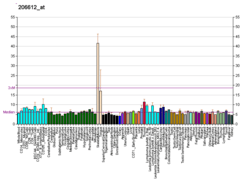CACNG1
Voltage-dependent calcium channel gamma-1 subunit is a protein that in humans is encoded by the CACNG1 gene.[5][6]
L-type calcium channels are composed of five subunits. The protein encoded by this gene represents one of these subunits, gamma, and is one of several gamma subunit proteins. This particular gamma subunit is part of skeletal muscle 1,4-dihydropyridine-sensitive calcium channels and is an integral membrane protein that plays a role in excitation-contraction coupling. This gene is a member of the neuronal calcium channel gamma subunit gene subfamily of the PMP-22/EMP/MP20 family and is located in a cluster with two similar gamma subunit-encoding genes.[6]
See also
References
- 1 2 3 GRCh38: Ensembl release 89: ENSG00000108878 - Ensembl, May 2017
- 1 2 3 GRCm38: Ensembl release 89: ENSMUSG00000020722 - Ensembl, May 2017
- ↑ "Human PubMed Reference:".
- ↑ "Mouse PubMed Reference:".
- ↑ Iles DE, Segers B, Sengers RC, Monsieurs K, Heytens L, Halsall PJ, Hopkins PM, Ellis FR, Hall-Curran JL, Stewart AD, et al. (Oct 1993). "Genetic mapping of the beta 1- and gamma-subunits of the human skeletal muscle L-type voltage-dependent calcium channel on chromosome 17q and exclusion as candidate genes for malignant hyperthermia susceptibility". Hum Mol Genet. 2 (7): 863–8. doi:10.1093/hmg/2.7.863. PMID 8395940.
- 1 2 "Entrez Gene: CACNG1 calcium channel, voltage-dependent, gamma subunit 1".
Further reading
- Gerhard DS, Wagner L, Feingold EA, et al. (2004). "The status, quality, and expansion of the NIH full-length cDNA project: the Mammalian Gene Collection (MGC)". Genome Res. 14 (10B): 2121–7. doi:10.1101/gr.2596504. PMC 528928. PMID 15489334.
- Strausberg RL, Feingold EA, Grouse LH, et al. (2003). "Generation and initial analysis of more than 15,000 full-length human and mouse cDNA sequences". Proc. Natl. Acad. Sci. U.S.A. 99 (26): 16899–903. doi:10.1073/pnas.242603899. PMC 139241. PMID 12477932.
- Chu PJ, Robertson HM, Best PM (2002). "Calcium channel gamma subunits provide insights into the evolution of this gene family". Gene. 280 (1–2): 37–48. doi:10.1016/S0378-1119(01)00738-7. PMID 11738816.
- Burgess DL, Gefrides LA, Foreman PJ, Noebels JL (2001). "A cluster of three novel Ca2+ channel gamma subunit genes on chromosome 19q13.4: evolution and expression profile of the gamma subunit gene family". Genomics. 71 (3): 339–50. doi:10.1006/geno.2000.6440. PMID 11170751.
- Burgess DL, Davis CF, Gefrides LA, Noebels JL (2000). "Identification of three novel Ca(2+) channel gamma subunit genes reveals molecular diversification by tandem and chromosome duplication". Genome Res. 9 (12): 1204–13. doi:10.1101/gr.9.12.1204. PMC 311002. PMID 10613843.
- Iles DE, Segers B, Weghuis DO, et al. (1993). "Localization of the gamma-subunit of the skeletal muscle L-type voltage-dependent calcium channel gene (CACNLG) to human chromosome band 17q24 by in situ hybridization and identification of a polymorphic repetitive DNA sequence at the gene locus". Cytogenet. Cell Genet. 64 (3–4): 227–30. doi:10.1159/000133583. PMID 8404045.
- Powers PA, Liu S, Hogan K, Gregg RG (1993). "Molecular characterization of the gene encoding the gamma subunit of the human skeletal muscle 1,4-dihydropyridine-sensitive Ca2+ channel (CACNLG), cDNA sequence, gene structure, and chromosomal location". J. Biol. Chem. 268 (13): 9275–9. PMID 8387489.
External links
- CACNG1+protein,+human at the US National Library of Medicine Medical Subject Headings (MeSH)
- Human CACNG1 genome location and CACNG1 gene details page in the UCSC Genome Browser.
This article incorporates text from the United States National Library of Medicine, which is in the public domain.




